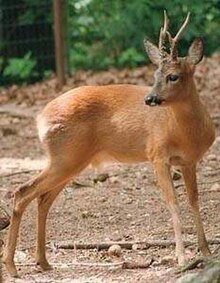Siberian roe deer
| Siberian roe deer | |
|---|---|
 |
|
| Scientific classification | |
| Kingdom: | Animalia |
| Phylum: | Chordata |
| Class: | Mammalia |
| Order: | Artiodactyla |
| Family: | Cervidae |
| Subfamily: | Capreolinae |
| Genus: | Capreolus |
| Species: | C. pygargus |
| Binomial name | |
|
Capreolus pygargus (Pallas, 1771) |
|
| Subspecies | |
|
|
The Siberian roe deer or eastern roe deer (Capreolus pygargus) is a species of roe deer found in northeastern Asia. In addition to Siberia and Mongolia, it is found in Kazakhstan, the Tian Shan Mountains of Kyrgyzstan, eastern Tibet, the Korean Peninsula, and northeastern China (Manchuria).
Its specific name , literally "white-rumped", is shared by the pygarg, an antelope known in the antiquity. The name was chosen by the German biologist Peter Simon Pallas in the late 18th century. The roe deer has long antlers.
The Siberian roe deer was once considered by some as the same species as the European roe deer (Capreolus capreolus), but it is now considered to be separate. It has larger antlers with more branches than those of European roe deer. The Siberian species can be found across central Asia and in the Caucasus Mountains and weighs up to 59 kg (130 lb). The Siberian and European roe deer meet at the Caucasus Mountains with the Siberian roe deer occupying the northern flank, and the European roe deer occupying the southern flank, Asia Minor, and parts of northwestern Iran. Roe deer can jump distances up to 15 m (49 ft), and generally live about 8–12 years, with a maximum of about 18 years.
The two subspecies of Siberian roe deer are C. p. pygargus and C. p. tianshanicus (named for the Tian Shan mountains).
The Siberian roe deer is a moderately sized metacarpalian deer, with a long neck and large ears. In winter the northern populations exhibit light gray coloring, but their southern counterparts are grayish brown and ochraceous. The belly is creamy and the caudal patch is white. In the summer, their coloring is reddish. Young have a spotted coat. Males are larger and have three-tined antlers, widely spaced and slanting upward, which are shed in the autumn or early winter and begin to regrow shortly thereafter.
...
Wikipedia

